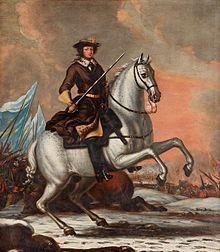Caroleans
[1] The Caroleans are particularly associated with Charles XII and his campaigns in the Great Northern War (1700–1721), during which they achieved a series of impressive victories, often against considerably larger enemy forces, and established themselves as one of the most feared and respected armies in Europe.
Overall, 350,000 soldiers from Sweden, Finland, and the Baltic provinces died in the service of Charles XII during the Great Northern War, mostly from non-combat causes.
[2] In the early and mid-seventeenth century, the Kingdom of Sweden established a large empire in the Baltic Sea region and Northern Germany.
Its success rested in large part on the quality of its armed forces, which pioneered numerous innovations later adopted by other European armies and were well-organised and generally well-led.
A bayonet-equipped musket was considered to be more practical for that, as it gave greater reach than a sword when facing a mounted opponent and could be braced against the impact of a charge.
[16] Swedish military doctrine of the Carolean era was distinguished by its emphasis on aggressive action and shock tactics, the so-called gå-på (literally "go-on") method.
This attitude stood in contrast to other European armies of the period, which were coming to rely increasingly on musketry, delivered in the form of volley fire by line infantry, to win battles.
[11] Gå-på tactics enabled the Caroleans to repeatedly overcome much larger enemy armies, as the psychological impact of their rapid approach and their steely discipline under fire, combined with their fearsome reputation, often served to unsettle the opposing troops even before physical contact was made.
[18] The preference for aggressive action also served, perhaps counterintuitively, as a way to reduce losses, as it ensured that battles would be resolved quickly rather than degenerating into bloody attritional struggles, as often happened when two armies using volley tactics clashed.
This was especially important for the Swedish army as it lacked the manpower reserves of larger neighbours like Poland-Lithuania and Russia, and thus could not replenish its ranks after heavy defeats.
The latter scenario occurred at the Battle of Poltava, where Peter the Great was able to lure Charles XII into mounting an attack against a Russian camp protected by field fortifications, leading to an overwhelming Swedish defeat.
Never have I seen such a combination of uncontrollable dash andperfectly controlled discipline, such soldiers and such subjectsare not to be found the wide world over except in Sweden According to army regulations of 1694 and 1701, infantry attacks were to be executed as follows: In four ranks with gaps, a Swedish battalion would march "smoothly and slowly" towards the enemy lines, braving enemy fire that often started at a distance of approximately 100 metres.
Often, complete ranks of enemies fled before physical contact was made, frightened by the long pikes and the fact that the Swedish battalions had previously calmly withstood their fire.
The slow march was replaced by running, to take fewer casualties and begin combat sooner, while optimally still frightening the enemy with a swift, unflinching advance into their fire.
[23] In addition to swearing fidelity to the Swedish king, the soldiers had to learn and follow the precepts and Lutheran doctrines of the Church of Sweden, and those who flouted religious regulations could be punished severely.
[24] Religion was especially important for building cohesion among the soldiers, who were recruited from all over the Swedish Empire, including Bremen-Verden, Pomerania and Livonia, although Swedes and Finns always comprised a large majority.
Religion was therefore important for encouraging a sense of unity and common purpose amongst the heterogenous soldiery, especially in the face of enemies considered to be "heretics", such as the Catholic Poles or Orthodox Russians.
[23][24] The chaplains' sermons often reminded soldiers that they had God's protection and assistance in battle, a notion originating when Sweden fought in the Thirty Years War as the continental leader of Protestantism.
[citation needed] Good discipline was vital for the Swedish army's highly aggressive gå-på tactics, which required the Caroleans to keep in formation and hold their fire as they approached the enemy, even if coming under a hail of bullets themselves.
One way of inculcating such extreme self-control was by encouraging a sort of fatalism among the troops: soldiers were told not to be afraid of battle, since if God wanted them to survive then nothing could harm them, and conversely if He had decreed that they were to die then death would come even if they tried to flee.
New recruits were sorted into regiments based on particular provinces and districts, in order to encourage a sense of local pride and esprit de corps.
[23] Abuses against civilians were also not unheard-of, although Charles XII issued strict ordinances against such excesses during his Polish and Saxon campaigns; several instances are recorded of Swedish soldiers being sentenced to death after flouting these orders.
[27] The term "Carolean" is not used for Swedish soldiers after the death of Charles XII in 1718, the return to constitutional monarchy under the 1719 Instrument of Government and the end of the Great Northern War in 1721.
However, the Swedish army continued to use the equipment, organisation and tactics of the Carolean period for the next sixty years, until the reforms of King Gustav III in the late 1770s.






A) by company , B) by battalion .



